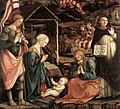History
The main structure in its present form was assembled during the late 13th century and early 14th century from the merger of three separate buildings, fused to house the local podestà, the judiciary and Prison. The different building materials, evident from the facade, still reveal the outlines of the earlier structures. The oldest part is the tower-house still discernible on the right (13th century), which had belonged to the family of Pipini, with a portico on the ground floor with pilasters of limestone then buffered but still visible. It was purchased in 1284 from the capitano del popolo Fresco Frescobaldi to house the municipal government. During the 16th century, the building, including the belltower, collapsed. The restoration added a new bell tower and crowning crenellations. The interiors were often divided into smaller rooms over time. Towards the end of 19th century, it was proposed for demolition, but by 1909 it was decided to restore the building.
The left hand part of the facade and building dates back to the 14th century and has eight elegant mullioned windows and a tabernacle. In this tabernacle, until at least 1799, stood a statue of the 14th century Robert of Anjou, once viewed as a defender of the city. Unfortunately, it was he, who sold Prato to Florence, ending the town's independence. From the portal on the ground floor one enters a series of rooms with original frescoes: the earliest frescoes (1307) by Bettino Corsino and later frescoes (1425) by Pietro di Miniato and Antonio di Miniato. The wide outdoor staircase leads to the main floor.
The Grand Duke Peter Leopold of Lorraine in 1788 expressed the intention of creating a school of design in Prato. By 1858, a collection of works in Prato were being assembled in a civic museum, housed in the nearby Palazzo Comunale. From 1912, the Palazzo Pretorio has hosted the Museo Civico, which contains many works of art ranging from medieval times to the 19th century.
Lateral Entrance
The Museum of Palazzo Pretorio and Piazza del Comune
The statue of Datini in front of Palazzo Pretorio
Palazzo Pretorio with statue of Marco Datini
This page is based on this
Wikipedia article Text is available under the
CC BY-SA 4.0 license; additional terms may apply.
Images, videos and audio are available under their respective licenses.










